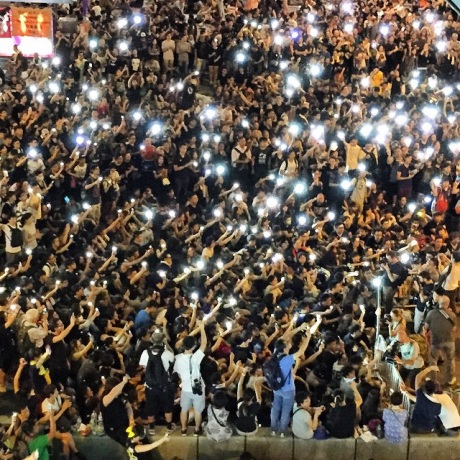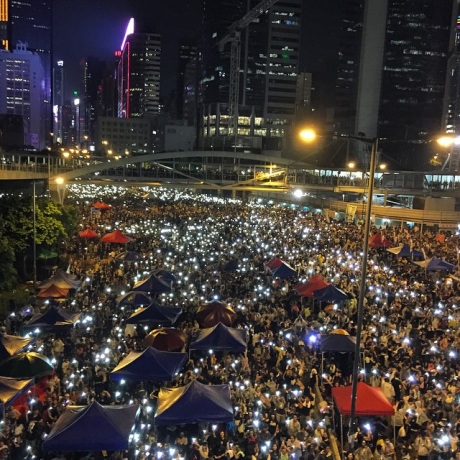The unexpected leaders of Hong Kong's protests
“Occupy Central” was never intended to be a surprise. Discussed, debated and planned by its leaders – senior democratic political figures in Hong Kong – it was always intended to be a well-organized protest in the central business district of Hong Kong beginning on October 1, a public holiday. So the last few days in Hong Kong have been the last thing anyone expected: a complete surprise.
The surprise came from the young people of Hong Kong. The Hong Kong Federation of Students last week commenced a week-long student strike which was originally intended as a “curtain-raiser” event to prepare for the “main event”, the formal Occupy Central. The students’ week of action culminated in a protest at government headquarters last Friday night. When a group of students tried to occupy Civic Square at the entrance to the legislative council offices, they were surrounded by police. Larger crowds gathered demanding that the students be released and the square be re-opened to the public.
There was a tense stand-off between crowds and police over the next 24 hours in the streets surrounding the government headquarters as the protesters barricaded their positions in advance of an expected police effort to clear them. This culminated in Occupy Central leader Benny Tai announcing in the early hours of Sunday morning that “Occupy Central” had formally commenced – in Admiralty district rather than in Central, and three days earlier than planned.
A series of miscalculations by the police and the Hong Kong government then caused matters to escalate very quickly.
Their first miscalculation was to cordon off the protest site around government headquarters early on Sunday afternoon to prevent others joining the protest. Crowds flocked to the surrounding area, quickly outnumbering police, and, by late Sunday afternoon, the police had found themselves sandwiched between two groups of protesters. The protesters surrounding the police who were surrounding the initial protesters overwhelmed the roads, brought traffic to a standstill and were soon confronting the police barricade and demanding access to the protest site. At this point police had lost control of the situation.
Their second miscalculation was to resort to disproportionate force too quickly and without provocation. Granted, the protesters were pushing up against a police barricade, but they were armed only with collapsible umbrellas and cling film, no match for riot shields and capsicum spray. We do not know whether it was an official order or a nervous police officer that led to the first rounds of tear gas being fired. It is the kind of thing a commission of enquiry would usually discover, but we are unlikely to get one. What is clear is that the tear gas came without warning, and caused first panic, then shock and then outrage among protesters and citizens watching the protests at home, drawing many more to the protest site.
Their third miscalculation on Sunday night was to continue to deny citizens access to the protest site, leaving them in a position where they continued to block the main highway through Hong Kong. This then led them to attempt to clear the area by forming a line of riot police and vehicles in Central, which was presumably intended to advance down the main road towards the Admiralty protest site, clearing the road and arresting protesters as they advanced. But as they formed their line to prepare their advance, new crowds on the Central side of their line again began to gather, and the police yet again found themselves overwhelmed by crowds on both sides of their defensive line. Even if they had managed to advance on Admiralty, a crowd just as large would have filled in the newly-cleared space behind them. They were left with no choice but to fire more rounds of tear gas, in both directions into the crowds in front and behind them, and under the cover of the gas to beat a hasty retreat.
It was clear that police and government were completely unprepared for the spontaneity and scale of the protests, leading to their appalling mismanagement of the situation. We are told that they had trained for months, and that may have been part of the problem with their reaction on Sunday – they had been trained as riot police, and this was no riot. It was a rowdy, but peaceful and non-violent, demonstration – anyone who tried to do so much as throw an empty plastic bottle was quickly stopped by fellow protesters. But to a hammer, everything looks like a nail.
Since Monday morning, the Hong Kong authorities have conceded the city to the protesters. There has been almost zero police presence on the streets, and despite this, there have been no public order problems, no vandalism, no looting, no violence.
Since formally announcing their launch on the back of the student occupation on Sunday morning, the “adult” Occupy Central group has not yet managed to “own” this movement. The protesters have been overwhelmingly the youth – university students, high school students, young adults. They are the world’s best-behaved and most community-minded protesters, and have built an almost utopian community on the streets: distributing free water, food and supplies, establishing first aid stations and libraries, collecting rubbish and sorting it for recycling, and still finding time to do their homework.
Even at the press conference on Wednesday evening, when asked what their next steps would be, Occupy Central leaders replied that they would “defer to the students,” as this was now their movement, and Occupy Central saw themselves only as “partners” assisting them. Whether this is respectful due deference, a pragmatic reflection of reality or an abdication of responsibility remains to be seen.
See Antony Dapiran’s photographs of the Occupy Central protests at www.instagram.com/antdhk
Antony Dapiran is a Hong Kong-based lawyer.















